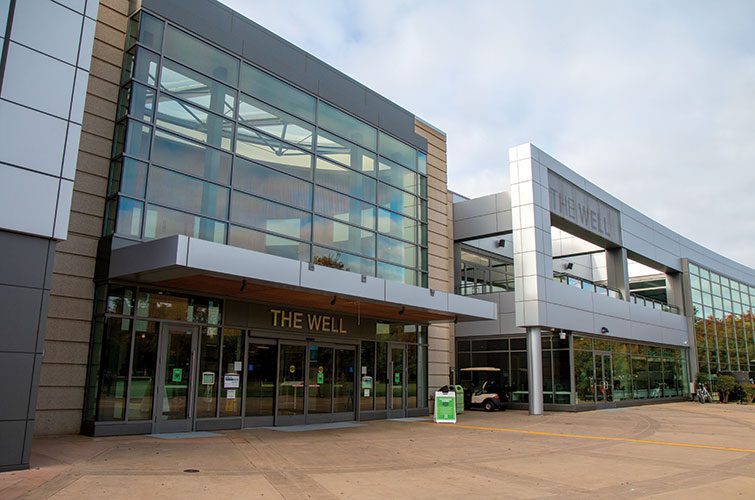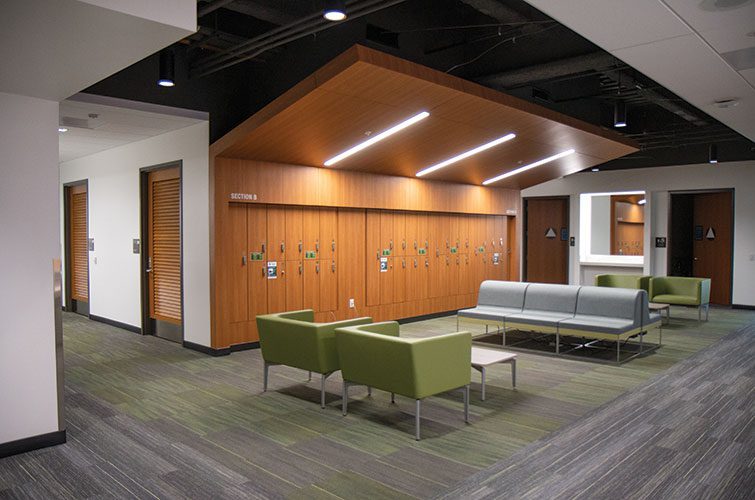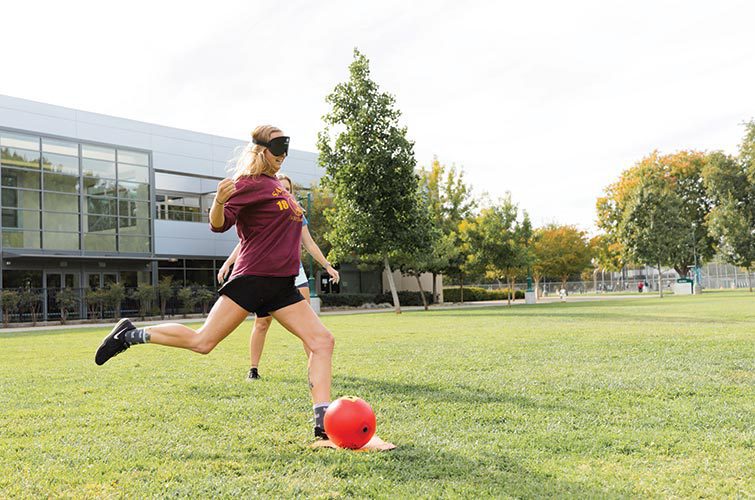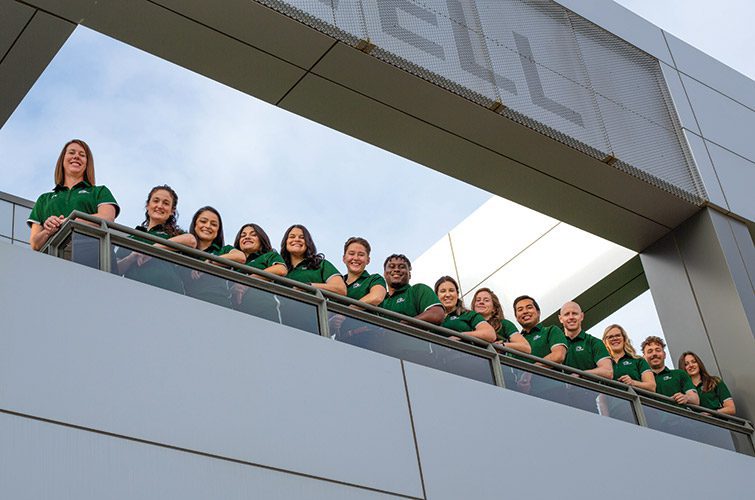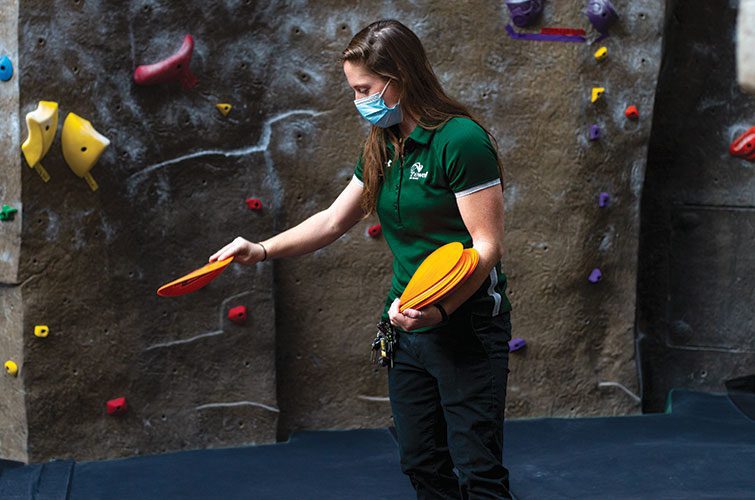When the university’s president asked her, “Why isn’t The WELL opening its doors?” in the fall of 2020, Kate Smith had to go with her gut.
“I don’t feel that’s a sustainable option going into the winter,” said Smith, the director of The WELL at California State University, Sacramento State (Sacramento State). “For us to be able to mobilize and be able to stay open throughout the winter and into the spring, I think utilizing this outdoor parking structure is going to be our best option.”
So, in November 2020 The WELL opened a 28,000-square-foot outdoor fitness facility on the first floor of a parking structure. And, the irony of it all was the day the facility opened was the day the region went back to requiring all indoor operations to close again. It seemed Smith’s gut had been right.
Despite having to install fencing, lighting and flooring, run electric, and move equipment, the team rallied around a decision that proved to be the best one possible in the end. “This was a huge milestone for our campus community and was an exemplary illustration of what it really meant to ‘pivot’ while serving students and the campus community,” said Smith. “We received an outpouring of gratitude from the students who were living in the area that this provided them an outlet and a sense of belonging during a time filled with stress, anxiety and loss.”
This idea of not being afraid to do things differently is a vein that runs throughout The WELL.
Inclusive Renovation
In fact, a recent expansion project that was completed in the fall of 2021 had a large focus on inclusive design, as well as expanding high-impact areas.
However, this project was different. Take the locker rooms for instance. Smith said historically all-gender spaces would be created for a specific population in mind. Through focus groups, they realized there wasn’t just one population that wanted more privacy: everyone did. “I think that comes from a few different reasons,” said Smith. “One, I think college students today have grown up unfortunately in an education system that did not have a traditional sense of what P.E. used to be.”
EXTRA CREDIT: Universal design is imperative in your facility. And here’s why.
So, in evaluating the locker room spaces, Smith said they decided to categorize by activity and go from there. For example, some users just need to change and store belongings. As such, they created an all-gender open space known as the Locker Hub. There are Hollman Lockers in an open environment, and then off that are all-gender dressing rooms. “It’s similar to what you might see at a department store,” said Smith.
The Retreat is a space with 16 all-gender showers and then separate all-gender restrooms. “The space is divided up into these smaller areas where the architects changed the privacy threshold,” explained Smith. “Instead of a room where your privacy threshold might be at the front door, you walk in and it’s just open with large hallways. And the privacy threshold now becomes when you need to shower or use the restroom.”
But the inclusive design didn’t stop there. Smith said they also have active unified sports and students with disabilities populations. As such, they have a fleet of sport wheelchairs. Larger than traditional wheelchairs, they don’t fit through the ADA-minimal required door width of 36 inches. So, The WELL added 46-inch-wide doors to the Locker Hub and The Retreat spaces.
EXTRA CREDIT: Here’s a look at developing policies regarding LGBTQA participation.
Smith explained it with a great analogy: “If you are an individual and you want to work out, you put your workout shoes on and you go to the gym,” she said. “If you need to use the restroom or another space, you don’t want to change your shoes to just go into that restroom door. That’s essentially the same as an individual who is using a wheelchair. They’re going to come and they’re going to get into a sport chair. They don’t want to have to transfer out of a sport chair into their traditional chair to use a restroom.”
Meeting Students Where They Are
And that is what The WELL loves to do: meet individuals where they are. In fact, Alivia Elder-Gok, the certified therapeutic recreation specialist, said that is the crucial role she plays. “All humans are different and have different needs; therefore, recreational therapy is exceptionally individualized to each person,” she said.
As such, Elder-Gok cultivates a therapeutic environment for students that supports a balanced and active life. “Recreational therapy means a treatment service designed to restore, remediate and rehabilitate a person’s level of functioning and independence in life activities to promote health and wellness by reducing or eliminating any activity limitations and restrictions of participation in life situations,” she said.
Recreation therapy includes a wide-variety of activities: wheelchair rugby, sit volleyball, nap classes, outdoor wellness classes, beep kickball, individual recreation therapy sessions, etc. Elder-Gok highlighted three programs specifically:
1. Volunteer Program
Volunteers are accepted on a semester basis. They provide support in the implementation and facilitation of inclusive and specialized recreation and leisure pursuits. “Making sure volunteers know how to support us helps ensure they feel valued while working with us,” said Elder-Gok.
2. Unified All-In-Recreation
Partnering with two local school districts in Sacramento, the program runs one day a week for eight weeks. It provides goal-oriented recreation and leisure opportunities to encourage social-emotional learning for students with disabilities. The two-to-one ratio of volunteers to transition students has ensured success in the program. Plus, Elder-Gok said the in-depth training in inclusion, specific disabilities and how to use the equipment is essential.
3. Recreational Therapy Internship Program
The paid internship requires 560 hours and follows the National Council for Therapeutic Recreation Certification credentialing standards. “Providing a Recreational Therapy Internship has allowed The WELL to have an additional Recreational Therapy staff member on the team with the necessary Recreational Therapy knowledge to support our WELL staff’s development and education while increasing the quality of experiences offered in The WELL membership,” said Elder-Gok.
Since the implementation of the Recreational Therapy department, Smith said it serves so much more than she ever realized. “I never knew how much we were missing until we had a Recreation Therapist onboard,” she said. “They have really become the glue that ties us to so many other departments on campus.”
A Joint Mission Equals Recognition
One of those ties has been with Student Health and Counseling. In fact, through the partnership and a joint mission statement, the campus has been able to achieve gold recognition for the American Council on Sports Medicine Exercise is Medicine On Campus (EIM-OC) program since 2020. It gained this recognition after implementing the assessment of physical activity as a vital sign.
While having a joint mission statement has led to that success, another piece is the fact The WELL has an exercise physiologist on staff. “The reason for that title is to help us tie more closely to Student Health and Counseling,” said Smith. “It gives us more validity when speaking with medical providers.”
Clarissa Jimenez, the exercise physiologist, oversees the personal training program. She will get referrals from the medical providers, after which assigned trainers will create movement plans.
EXTRA CREDIT: Sacramento State isn’t alone when it comes to the EIM-OC program. Here’s a deeper dive into the program and a look at another school who is part of it.
“It is our intention to connect with the individual and then build a plan with them that includes the right resources for success,” said Jimenez. “The impact this program creates stems from knowing each individual has the power and skills to create healthy change with their lives, simply because they know themselves best. As health and wellness professionals, it is our role to collaborate and walk this journey with our students, not to take the wheel and drive.”
While EIM-OC has seen participants find great success at Sacramento State, Jimenez made a note to not forget the small consistent steps that get each participant there. She said it’s those that need to be lifted up, rather than just the big stories of major transformations. “We celebrate making the choice to take the stairs, research healthy food options, taking time to meditate and having the courage to simply begin,” she said.
Growth in 2022 Starts with the Team
As 2022 kicks off, Smith noted growth is at the forefront. “We look to continue our virtual offerings and further expand and develop our EIM-OC program to serve more students and continue our multi-dimensional approach to well-being,” she said.
But while The WELL team isn’t afraid to do things differently, they don’t do them differently alone. Smith said she has never been prouder than witnessing how the team came together through the pandemic. Short-staffed while undergoing a $40 million expansion project and a pandemic spanning nearly two years now, it was understood success wouldn’t be found in isolation.
Ultimately, it’s the collective commitment to serve that has helped Sacramento State propel forward. So, if Smith can trust her gut on anything else, it’s that you go far as long as you go together.
“Prior to the pandemic, the following saying was posted on our break room wall: ‘If you want to go fast, go alone. If you want to go far, go together,’” she said. “Each individual embodied this saying this past year and the innovation, adaptability, resiliency and perseverance was inspiring to witness. We have become closer as a team because of what we have accomplished, and I will be forever grateful for this amazing team.”



